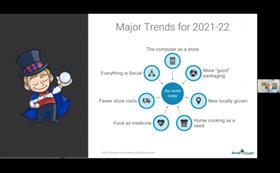
The latest consumer trends and changing eating habits as a result of the Covid-19 pandemic were the hot topics of the World of Fresh Ideas session 'New trends at point-of-sale'.
Raul Fernandez, president of Breakthrough Solutions, said that his company had done extensive research, through a North American survey, into how the market was changing in 2021, and what it would look like in the future.
'With people concerned about going to the store (due tot the pandemic), online channels have grown dramatically,' Fernandez explained. 'While people were forced into this to an extent, and shopping for groceries online can cause stress, consumers have realised that they could save time, and it is also more convenient for those with families. We expect this growth to continue.'
Indeed, looking ahead, shopping will become even more omni-channel, he predicted, with some not going back to the supermarket at all - choosing local markets over big retailers if they are going to step outside the home to shop.
Consumers want less non-compostable packaging, he continued, but they were also worried about safety and hygiene given the pandemic, which created something of a conflict.
Locally grown food will continue to flourish, Fernandez noted, especially with vertical farming advancing through improved technology and availability. In addition, home cooking is on the rise, and the foodservice industry will have to adapt as a result. He said there were clear marketing opportunities for major restaurant chains and leading chefs to tie-in with things like home delivery services.
'An obvious trend is that people have started eating a lot more products that have certain medicinal value, such as citrus with vitamin C,' he confirmed. 'This is an opportunity - it's not just about taste, crispness, shelf-life, it's also about adding nutritional value such as more antioxidants in blueberries.'
The final trend highlighted by Fernandez was the growing use of social media as a produce 'salesperson', with consumers increasingly influenced by things they see on the likes of Pinterest and Instagram. 'If you are a marketer of a product or own a brand, how can you maintain consumer trust and connection, and most importantly how can you avoid falling into the 'fake news' trap about your product and image?'
'The companies who are able to adapt to these changes will become dominant,' he concluded. 'It won't just be the big players who succeed, but it will mean opportunities for creative organisations, those who are faster and nimbler in adjusting to consumers needs.'



